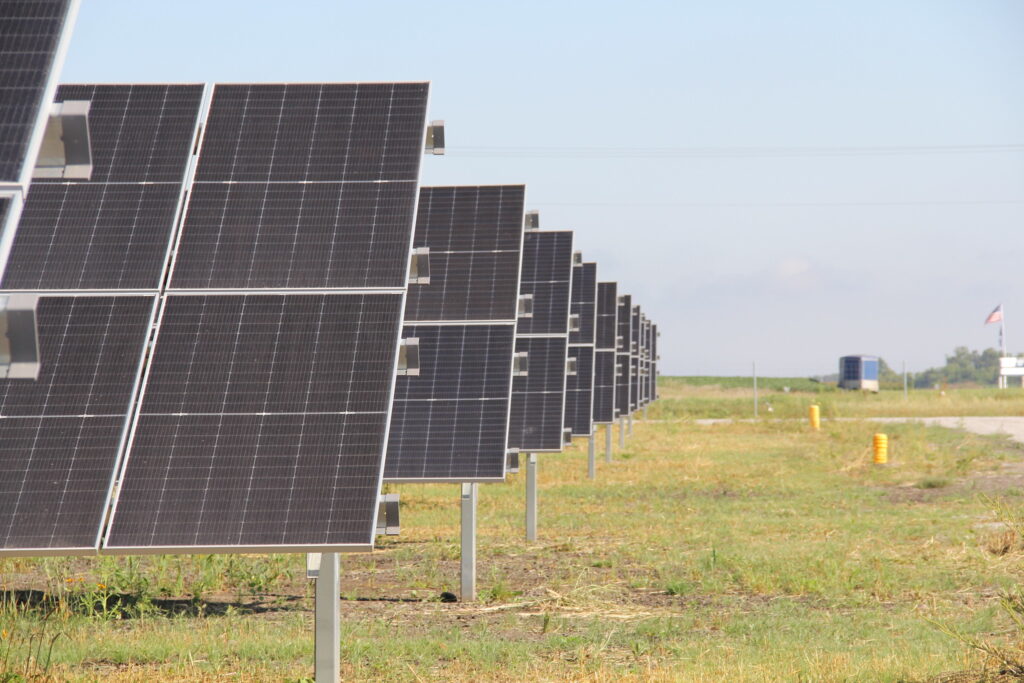Solar panels in Boone, Iowa. The U.S. Department of Agriculture announced Thursday, Sept. 5, 2024, it will distribute $7.3 billion in grants and loans for rural clean energy projects serving 23 states. (USDA photo)
A Wisconsin utility will be among 16 rural electric power cooperatives sharing in $7.3 billion from the federal government for clean energy projects that President Joe Biden will announce when he visits western Wisconsin Thursday.
The funds come from the 2022 Inflation Reduction Act, which included $13 billion in rural electrification programs administered by the U.S. Department of Agriculture (USDA).
That represents “the largest investment in rural electrification since 1936 and the New Deal,” Agriculture Secretary Tom Vilsack told reporters in a briefing Wednesday ahead of the announcement.
The funds announced Thursday are under the USDA’s Empowering Rural America program, dubbed New ERA. The New ERA federal grants and loans are projected to seed another $29 billion in private investment to produce more than 10 gigawatts of clean energy for rural communities — enough to power about 4 million homes according to one federal estimate.
La Crosse-based Dairyland Power Cooperative, which has customers in Iowa, Illinois and Minnesota as well as Wisconsin, will receive $573 million under the program, including a $471 million grant and a $102 million loan.
The federal funds will be part of $2.1 billion that Dairyland Power plans to invest in projects generating 1,080 megawatts of power, capable of supplying up to 800,000 homes. The co-op plans to build four solar power installations and four wind power installations, as well as enter eight agreements to purchase power from other solar and wind power providers.
Biden will make the announcement Thursday in the community of Westby, southeast of La Crosse.
The co-op has projected the projects will reduce the cost of electricity for Dairyland Power customers by 42% over the next decade.
The Dairyland projects are expected to reduce greenhouse gas pollution by 3 million tons a year, the equivalent of taking 729,000 gasoline-powered cars off the road each year, according to projections from the White House.
The federal aid “provides Dairyland and our member cooperatives with a tremendous opportunity to continue making vital investments in essential clean energy resources,” Dairyland President and CEO Brent Ridge said in a statement distributed by the USDA.
The funding “will drive substantial carbon reduction across the Dairyland system, facilitate new economic growth and job creation, promote environmental stewardship and lower energy costs for rural and agricultural communities.”
The 16 power co-ops taking part serve residents in 23 states. The initiative will “bring the promise of clean energy and lower costs to approximately 5 million rural households, representing 20% of the nation’s entire rural households, as well as farms and businesses that are located in those 23 states,” Vilsack said.
Collectively the 16 co-ops benefiting from the program are projected to add 4,500 jobs in addition to 16,000 construction jobs created for the work, according to the USDA. The projects include 3,700 megawatts of wind power, 4,700 MW of solar power, 800 MW of nuclear power and 357 MW of hydropower.
“All of this is designed not only to provide more reliant electricity for those rural communities, but will also result in a 43.7-million-ton annual reduction of greenhouse gas emissions,” Vilsack said.
The White House highlighted Dairyland’s relationships with unions representing electricians, steamfitters and other building trades workers. Vilsack said the Dairyland Power project will also include a community benefit plan incorporating union engagement and benefits for farmers.
“These benefit plans are designed to provide direct assistance and help to farmers who will benefit from this clean energy as well as connecting to employment opportunities,” Vilsack said. “You’ll see the opportunity for apprenticeships and training programs in order to build the workforce of the future.”
All projects funded through the Inflation Reduction Act must be fully completed by Sept. 30, 2031, according to administration officials.
The New ERA program is limited to rural electric cooperatives. Another USDA program, PACE (Powering Affordable Clean Energy), also funded through the Inflation Reduction Act, provides low-interest loans to rural energy providers for clean energy and energy storage projects. Vilsack said USDA has made 19 awards nationally under that program, totaling $665 million.
The Inflation Reduction Act also expanded the Rural Energy for America Program (REAP), which provides grants and loans to farmers and rural small businesses installing renewable energy systems or undertaking energy efficiency projects. The Biden administration has so far put $2.2 billion into that program, covering 7,600 projects.
In announcing the New ERA program and projects in Wisconsin, Biden will be taking something of a victory lap.
His Wisconsin visit as well as a stop in Michigan are “part of a broader effort that we’ve launched to hear directly from different communities across the country who are benefiting from the president’s investing in America agenda, and as a result, have peace of mind and more hope for the future,” White House Deputy Chief of Staff Natalie Quillian told reporters in Wednesday’s briefing.
When Biden and Vice President Kamala Harris took office in 2021, they “rejected conventional wisdom that trickle-down economics was the best path for America,” Quillian said. “Instead, President Biden built the economy from the middle out and the bottom up and made sure that instead of providing tax breaks for companies that ship jobs overseas, he invested here in America and in Americans.”
Thursday’s announcement, she said, joins other administration initiatives toward that end, including 350 road, bridge and other infrastructure repair projects in Wisconsin; $200 million set aside towards removing lead pipes in the state; and the first-ever enactment of a national standard for PFAS chemicals by the Environmental Protection Agency.
In 2021 Biden visited La Crosse and “laid out his plans for a better future,” Quillian said. “And when he returns tomorrow, he will have delivered on so many of those promises.”
GET THE MORNING HEADLINES DELIVERED TO YOUR INBOX

